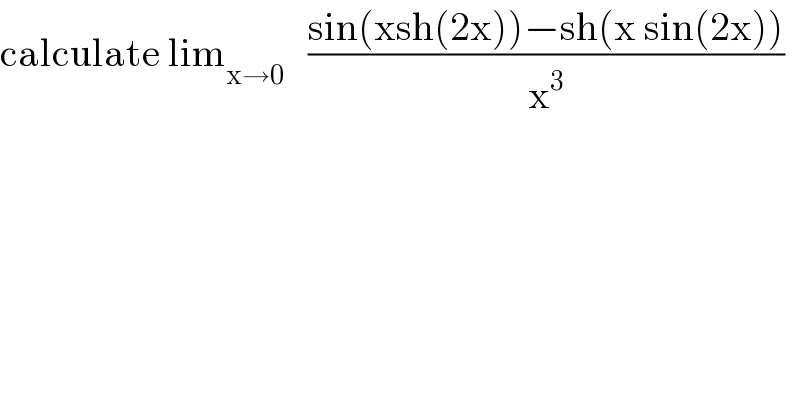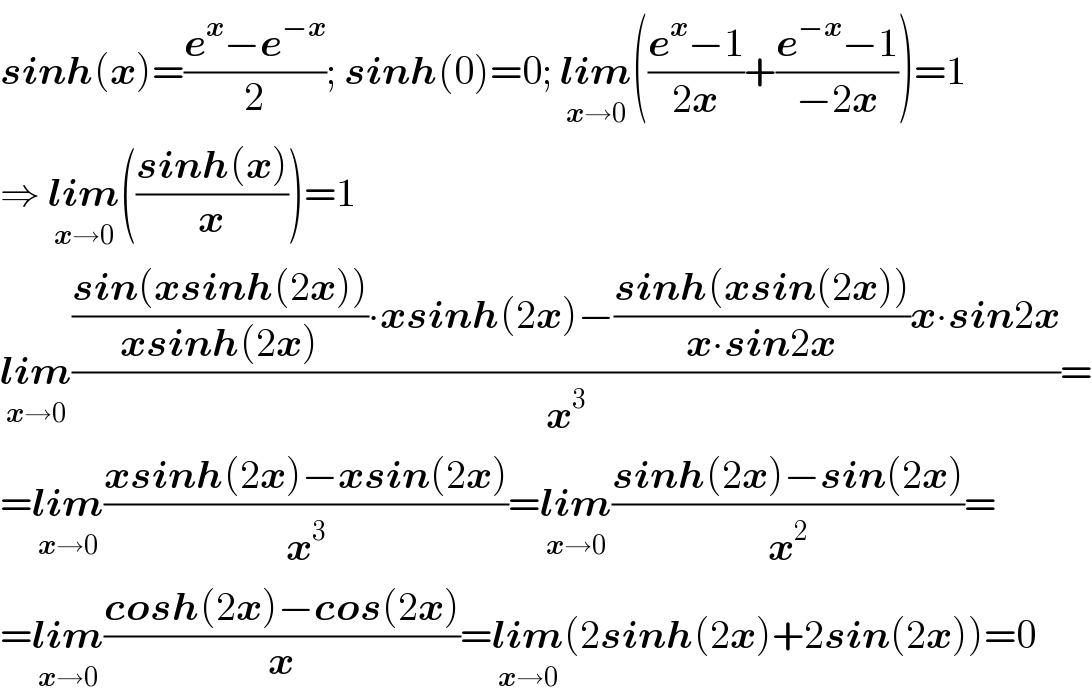
Previous in Relation and Functions Next in Relation and Functions
Question Number 117250 by mathmax by abdo last updated on 10/Oct/20

$$\mathrm{calculate}\:\mathrm{lim}_{\mathrm{x}\rightarrow\mathrm{0}} \:\:\:\frac{\mathrm{sin}\left(\mathrm{xsh}\left(\mathrm{2x}\right)\right)−\mathrm{sh}\left(\mathrm{x}\:\mathrm{sin}\left(\mathrm{2x}\right)\right)}{\mathrm{x}^{\mathrm{3}} } \\ $$
Answered by AbduraufKodiriy last updated on 10/Oct/20

$$\boldsymbol{{sinh}}\left(\boldsymbol{{x}}\right)=\frac{\boldsymbol{{e}}^{\boldsymbol{{x}}} −\boldsymbol{{e}}^{−\boldsymbol{{x}}} }{\mathrm{2}};\:\boldsymbol{{sinh}}\left(\mathrm{0}\right)=\mathrm{0};\:\underset{\boldsymbol{{x}}\rightarrow\mathrm{0}} {\boldsymbol{{lim}}}\left(\frac{\boldsymbol{{e}}^{\boldsymbol{{x}}} −\mathrm{1}}{\mathrm{2}\boldsymbol{{x}}}+\frac{\boldsymbol{{e}}^{−\boldsymbol{{x}}} −\mathrm{1}}{−\mathrm{2}\boldsymbol{{x}}}\right)=\mathrm{1} \\ $$$$\Rightarrow\:\underset{\boldsymbol{{x}}\rightarrow\mathrm{0}} {\boldsymbol{{lim}}}\left(\frac{\boldsymbol{{sinh}}\left(\boldsymbol{{x}}\right)}{\boldsymbol{{x}}}\right)=\mathrm{1} \\ $$$$\underset{\boldsymbol{{x}}\rightarrow\mathrm{0}} {\boldsymbol{{lim}}}\frac{\frac{\boldsymbol{{sin}}\left(\boldsymbol{{xsinh}}\left(\mathrm{2}\boldsymbol{{x}}\right)\right)}{\boldsymbol{{xsinh}}\left(\mathrm{2}\boldsymbol{{x}}\right)}\centerdot\boldsymbol{{xsinh}}\left(\mathrm{2}\boldsymbol{{x}}\right)−\frac{\boldsymbol{{sinh}}\left(\boldsymbol{{xsin}}\left(\mathrm{2}\boldsymbol{{x}}\right)\right)}{\boldsymbol{{x}}\centerdot\boldsymbol{{sin}}\mathrm{2}\boldsymbol{{x}}}\boldsymbol{{x}}\centerdot\boldsymbol{{sin}}\mathrm{2}\boldsymbol{{x}}}{\boldsymbol{{x}}^{\mathrm{3}} }= \\ $$$$=\underset{\boldsymbol{{x}}\rightarrow\mathrm{0}} {\boldsymbol{{lim}}}\frac{\boldsymbol{{xsinh}}\left(\mathrm{2}\boldsymbol{{x}}\right)−\boldsymbol{{xsin}}\left(\mathrm{2}\boldsymbol{{x}}\right)}{\boldsymbol{{x}}^{\mathrm{3}} }=\underset{\boldsymbol{{x}}\rightarrow\mathrm{0}} {\boldsymbol{{lim}}}\frac{\boldsymbol{{sinh}}\left(\mathrm{2}\boldsymbol{{x}}\right)−\boldsymbol{{sin}}\left(\mathrm{2}\boldsymbol{{x}}\right)}{\boldsymbol{{x}}^{\mathrm{2}} }= \\ $$$$=\underset{\boldsymbol{{x}}\rightarrow\mathrm{0}} {\boldsymbol{{lim}}}\frac{\boldsymbol{{cosh}}\left(\mathrm{2}\boldsymbol{{x}}\right)−\boldsymbol{{cos}}\left(\mathrm{2}\boldsymbol{{x}}\right)}{\boldsymbol{{x}}}=\underset{\boldsymbol{{x}}\rightarrow\mathrm{0}} {\boldsymbol{{lim}}}\left(\mathrm{2}\boldsymbol{{sinh}}\left(\mathrm{2}\boldsymbol{{x}}\right)+\mathrm{2}\boldsymbol{{sin}}\left(\mathrm{2}\boldsymbol{{x}}\right)\right)=\mathrm{0} \\ $$
